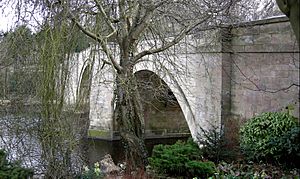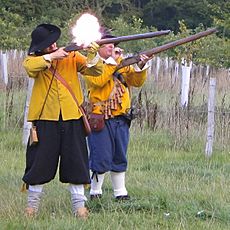Battle of Piercebridge facts for kids
Quick facts for kids Battle of Piercebridge |
|||||||
|---|---|---|---|---|---|---|---|
| Part of the First English Civil War | |||||||
 The 16th-century bridge over the Tees at Piercebridge |
|||||||
|
|||||||
| Belligerents | |||||||
| Commanders and leaders | |||||||
| Earl of Newcastle Sir Thomas Howard Sir William Lambton |
Captain John Hotham | ||||||
The Battle of Piercebridge was a fight that happened on 1 December 1642. It took place in County Durham, England, during the First English Civil War. This battle was important because it helped the Royalist army move south.
The Earl of Newcastle was leading an army of about 6,000 soldiers. They were marching from Newcastle upon Tyne to York. Their goal was to help the Royalist forces already in York. The Parliamentarians knew the Royalists were coming. So, they decided to defend the main river crossing at Piercebridge. This bridge crossed the River Tees.
About 580 Parliamentarian troops, led by Captain John Hotham, had set up defenses at the bridge. Newcastle sent an advance group of soldiers to attack. This group was led by Sir Thomas Howard. The Royalists used ten cannons from a nearby hill to attack the Parliamentarian defenses.
Sir Thomas Howard led his dragoons (soldiers who rode horses but fought on foot) to attack the bridge. After three hours of tough fighting, Captain Hotham and his men had to retreat. This allowed the Royalists to continue their march to York. Newcastle's army joining the fight in Yorkshire gave the Royalists more soldiers. This made the Parliamentarians change their strategy. They started using "Fabian tactics," which meant avoiding big battles.
Contents
Why Did the Battle Happen?
The First English Civil War had been going on for four months by December 1642. The war started because King Charles I and Parliament disagreed on many things. These disagreements had been building up for over 50 years.
The War in Northern England
Even before the war officially started, Yorkshire was a very important area. In January 1642, King Charles tried to arrest some members of Parliament. After this, people started openly choosing sides. They also began preparing for war.
Sir John Hotham took control of Hull for Parliament. The King left London and set up his base in York in March. He tried to take Hull twice but failed. Then, he went south to Nottingham.
In Yorkshire, the King's forces were led by the Earl of Cumberland. The Parliamentarians did not have one single leader there. Lord Fairfax led their forces in the West Riding. Sir John Hotham controlled most of the East Riding. Sir Hugh Cholmeley had soldiers in Scarborough.
Attempts at Peace in Yorkshire
After the King left in August, some leaders tried to stop the war from getting worse in Yorkshire. But they also kept gathering troops. Lord Fairfax met with some Royalist leaders on 29 September. They signed a agreement called the Treaty of Neutrality.
This treaty hoped to stop the fighting in Yorkshire. It said that both sides should stop recruiting soldiers. It also said that all of Yorkshire should unite against any outside army. However, neither the Hothams nor Cumberland signed it. This meant the treaty eventually failed. Parliament also rejected the treaty. By mid-October, Lord Fairfax gave up on the treaty and continued military actions.
Royalist Control in the North
North of Yorkshire, William Cavendish, Earl of Newcastle, was put in charge of the Royalist forces. He controlled Cumberland, Durham, Northumberland, and Westmorland. By mid-October, Newcastle had full control of these four counties for the Royalists.
King Charles's wife, Queen Henrietta Maria, had gone to Europe to get weapons. Newcastle was also responsible for making sure she could return safely. He also had to protect her once she arrived.
Preparing for Battle
By late September, some Royalist leaders in Yorkshire felt threatened. Parliamentarian forces surrounded York on three sides. They asked Newcastle for help. Newcastle agreed, but with conditions. His troops in Yorkshire had to be paid and fed by the Yorkshire Royalists. Also, he could leave Yorkshire to protect Queen Henrietta Maria when she returned.
Once the agreement was made, Newcastle trained his troops. In late November, he began his march south from Newcastle upon Tyne. His army had about 6,000 men. This included 4,000 foot soldiers (infantry), 2,000 horse soldiers (cavalry and dragoons), and ten cannons.
Lord Fairfax, the Parliamentarian commander in Yorkshire, knew Newcastle was coming. On 9 November, he sent Captain John Hotham to gather troops in the North Riding. Hotham pushed the Royalists north. He camped at Piercebridge on 23 November.
Piercebridge was the main crossing point on the River Tees. This river formed the border between County Durham and Yorkshire. Newcastle had to use this bridge, especially in winter when the river was hard to cross. To stop Newcastle, Hotham placed about 580 men (400 infantry and 180 cavalry) with two cannons on the south side of the bridge.
Who Fought at Piercebridge?

An infantry regiment (a group of foot soldiers) had both musketeers and pikemen. Musketeers used muskets. These guns were accurate up to about 150 yards (137 meters). They took about a minute to reload. Pikemen carried long wooden poles called pikes. These pikes were about 15 to 18 feet (4.6 to 5.5 meters) long. Pikemen mostly defended the musketeers from cavalry attacks.
Dragoons were soldiers who rode horses but fought on foot. They were good for scouting or leading attacks because they could move quickly. They rode to the battle, then got off their horses to fight. Cavalry soldiers stayed on their horses to fight. Most were harquebusiers. They wore helmets and chest armor. They carried a sword, two pistols, and a carbine (a shorter gun).
At Piercebridge, Captain Hotham commanded three groups of cavalry. These were his own group, Wray's, and Hatcher's, each with 60 men. The foot soldiers were from Sir Matthew Boynton's regiment.
Newcastle sent his advance group, called the vanguard, into Piercebridge. This group included Sir William Lambton's Regiment of Foot and Sir Thomas Howard's Regiment of Dragoons. We don't know exactly how many men were in these groups. A regiment could have anywhere from 500 to 1,200 men.
The Battle Unfolds
On 1 December, Newcastle ordered his advance group, led by Sir Thomas Howard, to attack Piercebridge. The Royalists used a smart tactic. They placed their ten cannons on Carlbury Hill, northeast of the bridge. From there, they could fire down on the Parliamentarian defenses.
Howard's dragoons led the attack through the village, which was north of the bridge. It's thought that Hotham had some men hidden in the village buildings. The dragoons pushed these defenders back. The bridge itself was blocked with defenses. The Parliamentarians had two light cannons covering the bridge. These were either on the bridge or on higher ground to the south.
Behind the dragoons, Lambton's foot soldiers followed. The dragoons, infantry, and cannons attacked together for several hours. During this intense fighting, Sir Thomas Howard was killed. The Parliamentarians said they had very few casualties. But they eventually retreated south. They kept firing to cover their retreat.
What Happened Next?
The Parliamentarians retreated south through Yorkshire to Knaresborough. With the way clear, Newcastle continued his march to York. He arrived there on 4 December. His advance had split the Parliamentarian forces. They still held strong areas in Hull and in the West Riding towns.
Newcastle continued his success by defeating Fairfax at the Battle of Tadcaster on 6 December. He also captured Leeds and Pontefract Castle. However, his campaign then slowed down. The Royalists were stopped at Bradford, where the local people fought against them. Newcastle soon stopped fighting and settled down for the winter.
In the short term, the Royalists gained power in Yorkshire. Newcastle had more soldiers. This made Lord Fairfax use a "Fabian strategy." This meant avoiding big, open battles. Instead, he focused on smaller attacks to wear down the Royalists. In the long term, these Parliamentarian tactics helped them win a big victory at the Battle of Marston Moor in 1644.
The 16th-century bridge at Piercebridge is still there today. It was made wider in the 18th century for more traffic. The village of Piercebridge is probably not much bigger now than it was during the battle. Some old earthworks (mounds of earth) found above Cliffe might be where the Parliamentarian cannons were placed.
Images for kids


